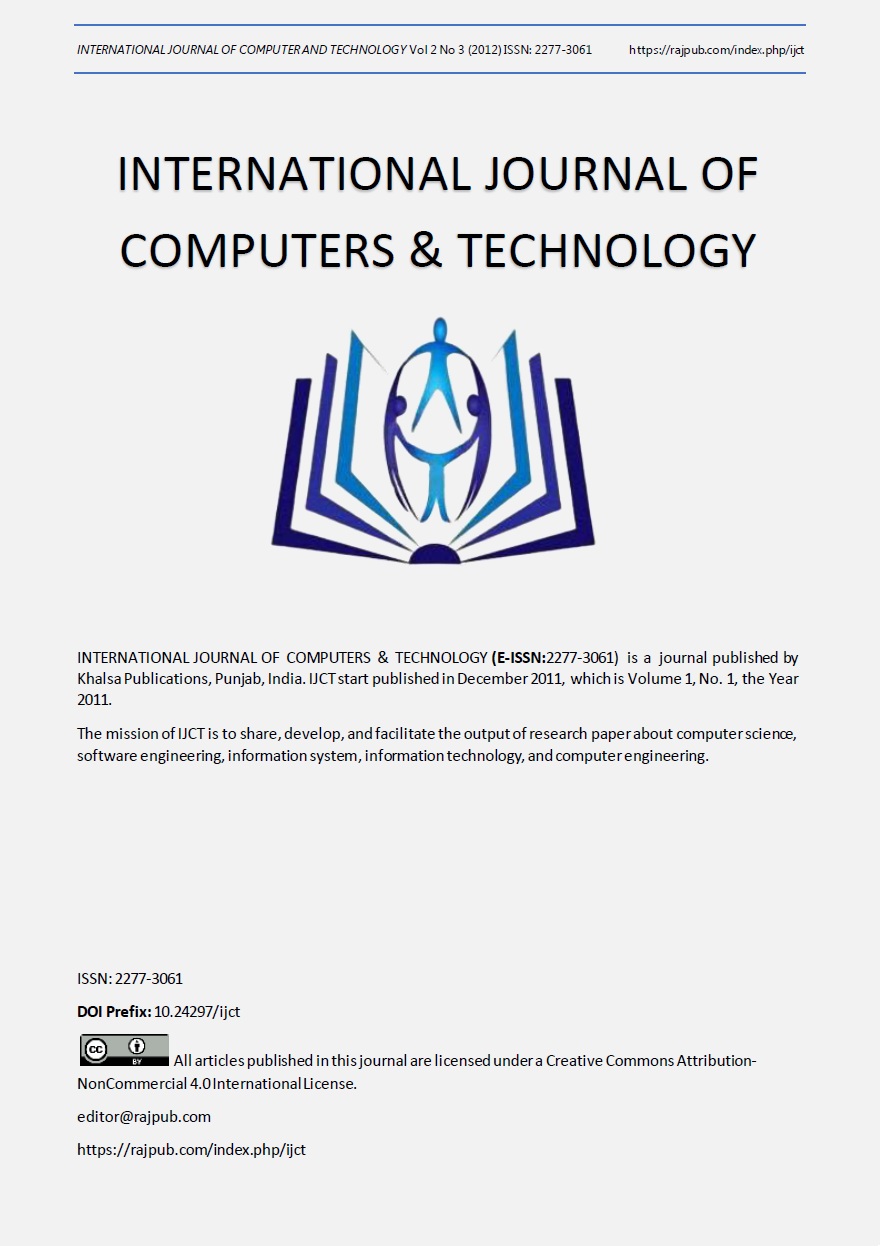Path Mechanism to reduce packet data loss in Wireless Mesh Networks
DOI:
https://doi.org/10.24297/ijct.v2i3c.6779Keywords:
wireless mesh network (WMN), path protocol, packet droppingAbstract
A wireless mesh network (WMN) is a communicationnetwork made up of radio nodes organized in a meshtopology. Wireless mesh network often consists of meshclients, mesh routers and gateways. A wireless Mesh networkuses multi-hop communication. Due to multi-hop architectureand wireless nature, Mesh networks are vulnerable to varioustypes of Denial of Services attack. It suffers from Packetdropping at Routing layer. Client nodes are unable to getservices from gateway nodes, hence network gets down. ThePaper emphasis on the developing of a path protocol when theminimun possible packet dropp occurs in wireless meshnetworks. Due to packet droping occurrences the networkperformance degrades. In the work, we have evaluated thePerformance of WMN under packet dropping on the basis oftheir throughput and Data packet loss.
Downloads
References
[2]. G. R. Hertz, S. Max, E. Weiß, L. Berlemann, D. Denteneer, and S. Mangold, “Mesh Technology enabling Ubiquitous Wireless Networks,†in Proceedings of the 2nd Annual International Wireless Internet Conference (WICON ’06), Boston, MA, USA: ACM, Invited Paper, pp. 11, August, 2006.
[3]. Yan Zhang, Jun Zheng “Book Title:-Security in Wireless Mesh Networksâ€.
[4]. w.steven,jan kryus, kyeongsoo kim, juan carlos zuniga “802.11s tutorial overview of the amendment for wireless local area networking†in ieee802 plenary, dallas , November ,2006.
[5]. Akyildiz, I.F.; Xudong Wang “A Survey on Wireless Mesh Networks†in Communications Magazine, IEEE Volume 43, Issue 9, pp. S23 - S30, September 2005
[6]. www.meshdynamics.com/mesh-network-technology.html
[7]. A. Pirzada and C. McDonald, “Establishing trust in pure ad hoc networksâ€, in Proceedings of the 27th Australasian Conference on Computer Science, Vol. 26,pp. 181-199, 2004.
[8]. A. Patwardhan, F. Perich, A. Joshi, T. Finn, and Y.Yesha, “Querying in packs: trustworthy data management in ad hoc networksâ€, International Journal of Wireless Information Networks, Vol. 13, No. 4, pp. 263 – 274, October 2006.
[9]. C.Y. Tseng, P. Balasubramanyam, C. Ko, R. Limprasittiporn, J. Rowe, and K. Levitt, “A specificationbased intrusion detection system for AODVâ€, in Proceedings of the 1st ACM Workshop on Security of Ad Hoc and Sensor Networks, pp. 125-134, 2003.
[10]. G. Vigna et al., “An Intrustion Detection Tool for AODV-based Ad hoc Wireless Networksâ€, Annual Computer Security Applications Conf. (ACSAC 2004), Tucson, 2004, pp. 16–27
[11]. H. Yang, J. Shu, X. Meng, and S. Lu, “SCAN: selforganized network-layer security in mobile ad hoc networks,†IEEE Journal on Selected Areas in Communications, Vol 24, pp. 261-273, 2006.
[12]. J. S. Baras and T. Jiang, “Managing trust in selforganized mobile ad hoc networksâ€, in Proceedings of the 12th Annual Network and Distributed System Security Symposium (NDSS ’05), Invited Talk in the Wireless and Mobile Security Workshop, February 2005,San Diego, California, USA.
[13]. J. Sen, M. G. Chandra, P. Balamuralidhar, S.G. Harihara, and H. Reddy, “A distributed protocol for detection of packet dropping attack in mobile ad hoc networksâ€, in Proceedings of the International Conference on Telecommunications (ICT’07), Paper ID: 74, Track: AdRouting and Protocol, Penang, Malaysia.
[14]. Jaydip Sen “An Efficient Algorithm for Detection of Selfish Packet Dropping Nodes in Wireless Mesh Networksâ€, International Journal of Computer Information Systems and Industrial Management Applications, ISSN 2150-7988 Volume 3 (2011) pp. 363-37.
[15]. Lee, M.J;Jianliang Zheng; Young-Bae Ko; Shreshtha,D.M†Emerging Standards for Wireless Mesh Technologyâ€IEEE Wireless Communication, Vol 13,No. 2â€,2006.
[16]. M. Conti, E. Gregori, and G. Maselli, “Reliable and efficient forwarding in MANETs,†Ad Hoc Networks Journal, Vol 4, No 3, pp. 398-415, 2006.
[17]. N. A. Benjamin and S. Sankaranarayanan,“Performance of wireless body sensor based mesh An Efficient Algorithm for detection of Selfish Packet Dropping Nodes in Wireless Mesh Networks 369 network for health applicationâ€, International Journal of Computer Information Systems and Industrial Management Applications (IJCISIM), Vol 2, pp. 20 – 28,2010.
[18]. R. Mahajan, M. Rodrig, D. Wetherall, and John Zahorjan, “Sustaining cooperation in multihop wireless networks,†in Proceedings of the 2nd Conference on Symposium on Networked Systems Design and Implementation (NSDI’05), Vol 2, pp. 231-244, 2005.
[19]. S. Buchegger and J.-Y. L. Boudec, “Performance analysis of the CONFIDANT protocol: cooperation of nodes- fairness in dynamic ad-hoc networks,†in Proceedings of the 3rd ACM International Symposium on Mobile Ad Hoc Networking and Computing (MobiHoc’02), pp. 226-236, Lausanne, Switzerland, 2002.
[20]. S. Marti, T.J. Giuli, K. Lai, and M. Baker, “Mitigating routing misbehavior in mobile ad hoc networksâ€, in Proceedings of the 6th Annual International Conference on Mobile Computing and Networking (MobiCom ’00),pp. 255 – 265, 2000.
[21]. Sukla Banerjee,â€Detection/Removal of Cooperative Black and Gray Hole Attack in Mobile Ad-Hoc Networksâ€,Proceedings of the World Congress on Engineering and Computer Science,WCECS 2008,October 22-24,2008, San Francisco,USA.
[22]. Sheenu Sharma, Roopam Gupta,â€Simulation Study of Black hole Attack in Mobile Ad-hoc Networksâ€,Journal of Engineering Science and Technology,Vol 4 No.2 ,2009, 243- 250
[23]. T. Repantis and V. Kalogeraki, “Decentralized trust management for ad hoc peer-to-peer network’sâ€, in Proceedings of the 4th International Workshop on Middleware for Pervasive and Ad Hoc Computing (MPAC ’06), p. 6, April 2006, Melbourne, Australia.
[24].Y.L. Sun, W. Yu, Z. Han, and K.J.R. Liu, “Information theoretic framework of trust modeling and evaluation for ad hoc networksâ€, IEEE Journal on Selected Areas in Communications, Vol. 24, pp. 305 – 317, 2006.
[25]. Yu Cheng,Devu Manikantan Shila and Tricha Anjali,â€Channel-Aware Detection of Gray Hole Attacks in Wireless Mesh Networksâ€, Dept. of Electrical and Computer Engineering,Illinois Institute of Technology,Chicago,USA,2009.









